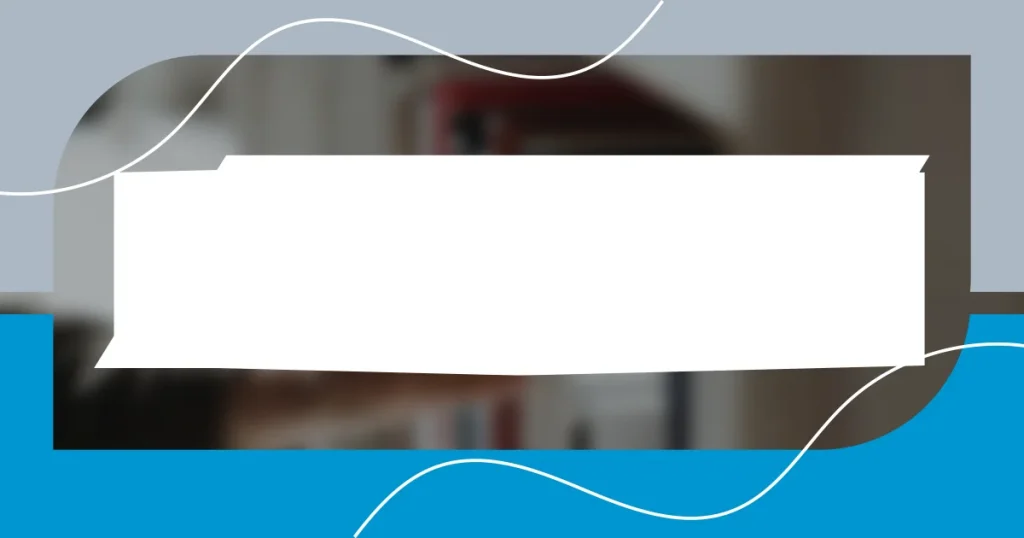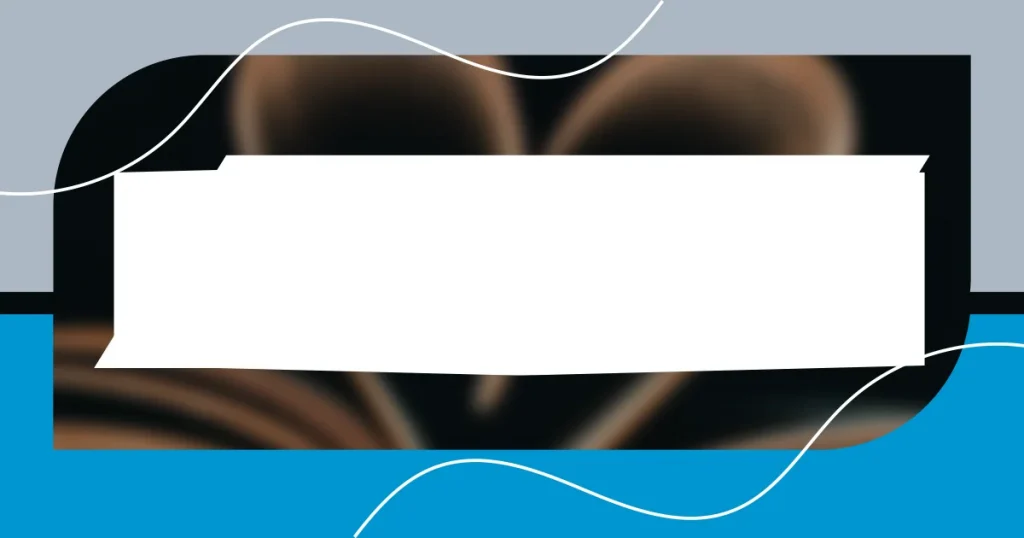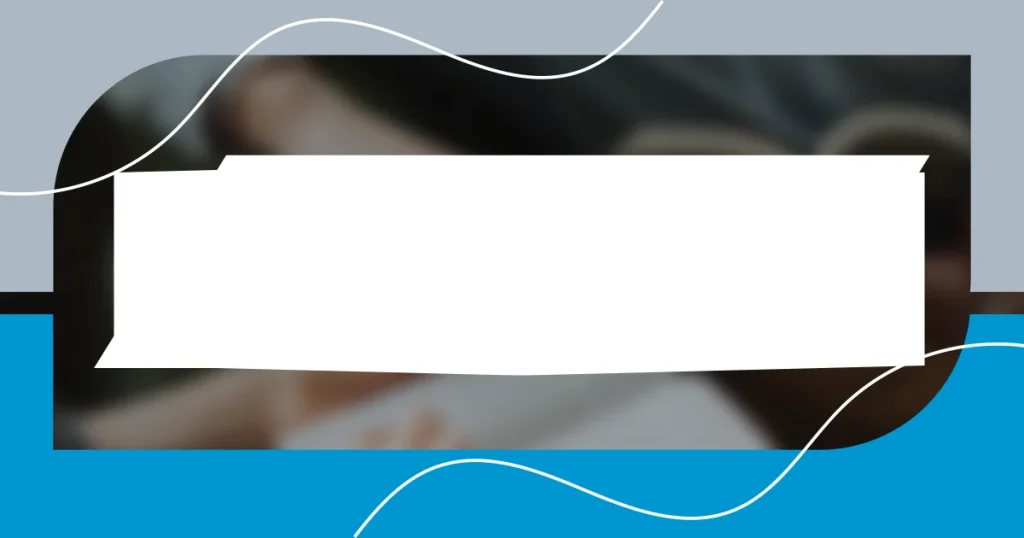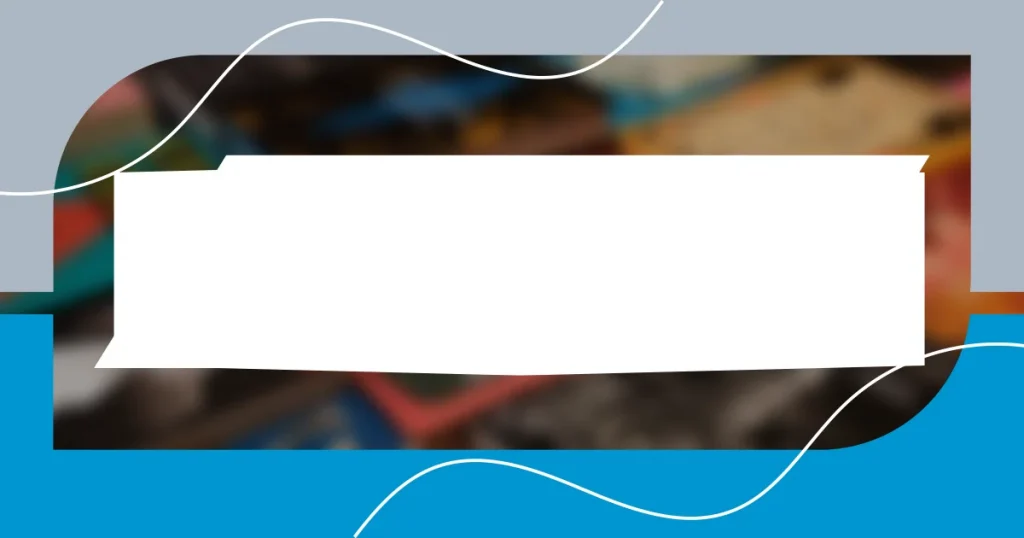Key takeaways:
- Assessing reading preferences involves identifying genres that resonate emotionally, alongside recognizing those that do not fulfill expectations.
- Researching authors and seeking recommendations enhances understanding and enjoyment of books, while evaluating reviews helps in finding titles that align with personal preferences.
- Setting a budget for books and organizing selections thoughtfully creates a more enriching and intentional reading experience.

Assessing my reading preferences
When I think about my reading preferences, I often recall the thrill of discovering a new genre that ignited my passion. For instance, the first time I picked up a fantasy novel, I felt an overwhelming sense of adventure that had me glued to the pages for hours. Has a book ever pulled you into a world so vividly that you lost track of time?
I also pay attention to the themes that resonate with me. I find myself drawn to stories about personal growth, perhaps because it reflects my own journey of self-discovery. It’s interesting how certain narratives can tap into our emotions and prompt introspection, isn’t it? Maybe it’s this connection that makes me appreciate those stories even more.
On the flip side, I don’t shy away from acknowledging the genres I struggle to enjoy. For instance, I’ve tried diving into classics, but sometimes they feel more like a chore than a joy. I often wonder—how can I push through, or should I trust my instincts and simply move on? Embracing what doesn’t work for me is just as crucial as celebrating what does.

Identifying favorite genres
I’ve found that identifying my favorite genres feels like an exciting treasure hunt. It’s about diving into different styles and uncovering what truly resonates with me. For example, I remember picking up a science fiction book that challenged my understanding of reality, and it left me buzzing with ideas well after I turned the last page. It’s those moments of realization that help me hone in on the genres I can’t resist revisiting.
To better understand my preferences, I’ve developed a little checklist that guides me:
- Emotional impact: Does the genre evoke strong feelings?
- Character development: Are the characters relatable or intriguing?
- Themes: Do the overarching themes connect with my personal experiences?
- Pacing: Is the narrative style engaging and easy for me to follow?
- World-building: How immersive is the setting, and does it spark my imagination?
By reflecting on these aspects, I get clearer insights into the genres I love—and steer away from those that just don’t hit the mark for me.

Researching authors and titles
Researching authors and titles reveals essential details that can significantly influence my reading choices. I often begin by checking online author profiles, engaging with their writing styles and previous works. For example, after discovering an author through a glowing recommendation, I couldn’t resist diving into their entire bibliography. It’s rewarding to feel that connection with the author’s voice across multiple titles. How do you feel when an author consistently captivates your interest? It’s like uncovering a hidden gem each time you read their work.
Word-of-mouth can be a powerful research tool as well. I love discussing books with friends and family to learn about their experiences with various authors and titles. Recently, a friend shared her thoughts on a book that transformed her perspective on life, and I couldn’t help but add it to my must-read list. That’s why I believe considering others’ opinions enriches my understanding of an author’s impact, ultimately guiding me toward authors whose work has affected readers deeply.
| Source of Information | Benefits |
|---|---|
| Online Profiles | Provides insight into an author’s writing style and previous works. |
| Word-of-Mouth | Fosters community insights and personal recommendations from trusted sources. |
| Literary Reviews | Helps understand the critical reception and thematic depth of a book. |

Evaluating book reviews and ratings
When it comes to evaluating book reviews and ratings, I often find myself sifting through a multitude of opinions to uncover the gems worth my time. I paid special attention to both the overall star ratings and the detailed reviews that seem genuinely authentic. I remember a time when a book had a mix of high ratings and some passionate criticisms; those critiques often highlighted aspects that resonated with me, which helped me determine if that book would align with my tastes. Have you ever spotted a book that everyone raved about, only to find that the nitpicky reviews actually pointed out the very elements you find bothersome? For me, those nuances can make all the difference!
It’s also crucial to differentiate between personal reviews and professional critiques. While both have their merits, I lean toward opinions that reflect personal experiences rather than simply discussing technical writing elements. For instance, I once read a review that mentioned how a book made the reviewer cry during a particular scene. That emotional connection sparked my interest—because if a story can evoke such feelings, it’s likely to resonate with me as well. Have you noticed that emotional highs often indicate a story worth investing in?
Lastly, I trust my instincts when it comes to book ratings. Sometimes, I hit a wall and find myself attracted to a book with a lower rating. I’ve learned that beyond the numerical rating lies the context of why readers enjoyed or disliked the book. I often find insightful commentary buried within the ratings that lead me down the rabbit hole of exploring deeper themes or unique narratives. Have you ever picked up a book that defied its rating and ended up loving it? It’s those bold choices that often lead to the most rewarding reading experiences for me.

Considering recommendations from friends
Considering recommendations from friends has always been a key part of how I curate my bookshelf. I remember one afternoon, curled up in a café with my best friend, she passionately described a novel that had sparked an unexpected joy in her life. Her enthusiasm was infectious, and I realized how much I valued her perspective. It felt like an invitation into a private world, and I knew I had to explore that book.
Sometimes, I find that friends see things in books that I might overlook. For instance, a coworker once urged me to read a young adult fantasy novel, insisting I would relate to its themes of friendship and self-discovery. Initially skeptical, I finally dove in, only to discover it resonated deeply with my own coming-of-age experiences. Isn’t it interesting how a shared connection can unlock new layers of meaning in a story?
Additionally, recommending a book to friends can be a rewarding experience too. I recall suggesting a memoir to a friend who was navigating a tough time, and the gratitude she expressed reminded me of the powerful bond between a reader and a story. It reinforced my belief that recommendations aren’t just about books; they carry our shared experiences and emotions, creating pathways toward understanding and connection. Don’t you think that personal touches add a unique richness to our reading choices?

Setting a budget for books
Setting a budget for books is a game-changer in my book-buying journey. I’ve learned the hard way that you can easily overspend when engulfed in excitement at a bookstore or an online sale. One time, I stumbled upon a sale that offered buy-one-get-one-free on hardbacks. While it felt like a fantastic deal, I walked out with titles I didn’t even want! Ever experienced buyer’s remorse after a book binge? It’s a humbling reminder to keep my finances in check.
When I set a specific budget for books each month, it makes my choices deliberate and thoughtful. I often allocate a certain amount, say $50, and then carefully consider how I want to spend it. Do I buy one hardcover and a couple of paperbacks, or do I splurge on an anticipated release? The challenge of staying within my budget actually enhances my book selection process. Have you ever found that putting a cap on spending allows you to focus more on what truly excites you?
To ensure I stick to my budget, I also keep an ongoing wishlist on my phone. This way, when I’m tempted to purchase impulsively while browsing, I can reference my list first. I often ask myself: “Is this book worth using a chunk of my budget on now, or should I wait for a better opportunity?” This habit has saved me from making hasty choices and regrets—a small victory, but one that helps make my reading experience more enjoyable!

Organizing the final selection
After gathering my final selection of books, I find that organizing them is both a fulfilling and a reflective process. I usually sort my titles based on theme, genre, or even emotions they evoke. For example, I have a dedicated shelf for feel-good reads, where my heart lifts just seeing the spines lined up together. Have you ever felt that rush of excitement flipping through books that truly resonate with you?
Next, I sometimes arrange my selections by color. It’s a simple yet visually pleasing method that turns my bookshelf into a work of art. One time, while organizing by color, I noticed that my collection of blue-covered books reflected a calmness that I often seek in life. It made me wonder—could the colors of our books subconsciously mirror our moods or aspirations?
Lastly, I can’t resist adding a personal touch to my organization. I often slip little notes or mementos between the pages of certain books, marking moments that made me smile or inspired me. For instance, a quote I jotted down during a workshop once found its home in the pages of a novel that sparked my creativity. Do you ever find yourself embedding memories within your books, making each reading a journey through both stories and your own experiences?
















